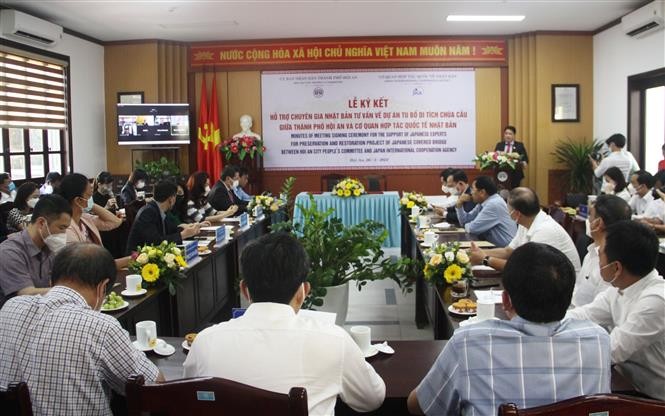
Japanese experts to help Hoi An restore Cau Pagoda
Latest
 |
| The signing ceremony between Hoi An city and the Japan International Cooperation Agency (JICA) on supporting the restoration of Bridge Pagoda. (Photo: VNA) |
Under the agreement, JICA will support Hoi An by sending experts to the city to help restore the pagoda. The activity may be adjusted depending on COVID-19 situation in Viet Nam and Hoi An. All arising issues will be settled by both sides.
Alongside, JICA will also help increase local capacity in preserving Hoi An Ancient Town's areas by providing the city with technical support.
Addressing the signing ceremony, Vice Chairman of the provincial People’s Committee Tran Van Tan highlighted the significance of the Japanese support in the restoration of the site. He proposed that the two sides promptly finalise necessary procedures to receive Japanese experts soon, so that restoration activities can start in mid-2022.
Cau Pagoda is situated right in Hoi An Ancient Town, connecting Tran Phu and Nguyen Thi Minh Khai roads.
Initially, the bridge was built by Japanese tradesmen possibly in the 17th century, thus it is also called the Japanese bridge.
It was not until 1653 that a tile-roofed structure was erected, connecting to the northern railings, protruding between the bridge, that’s why local people often call the covered bridge Chua Cau (Pagoda Bridge). The pagoda was renovated many times.
The current structure of Cau Pagoda was formed from renovations in the 18th and 19th centuries. Any visitors to the Hoi An Ancient Town are also impressed with the pagoda’s unique architecture: a tiled roof structure on top, a bridge below.
Although it is a pagoda, the pagoda is not worshipping the Buddha [like other typical pagodas in Viet Nam], but a spirit that protects and brings happiness to the local people.
Cau Pagoda is not only tourism symbol of the ancient town but also a place that connects the soul of the earth and Hoi An people.
The same day, the People’s Committee of Hoi An held a ceremony to receive a certificate recognising Hoi An Community House (Dinh Ong Voi) as a provincial-level relic site.

















